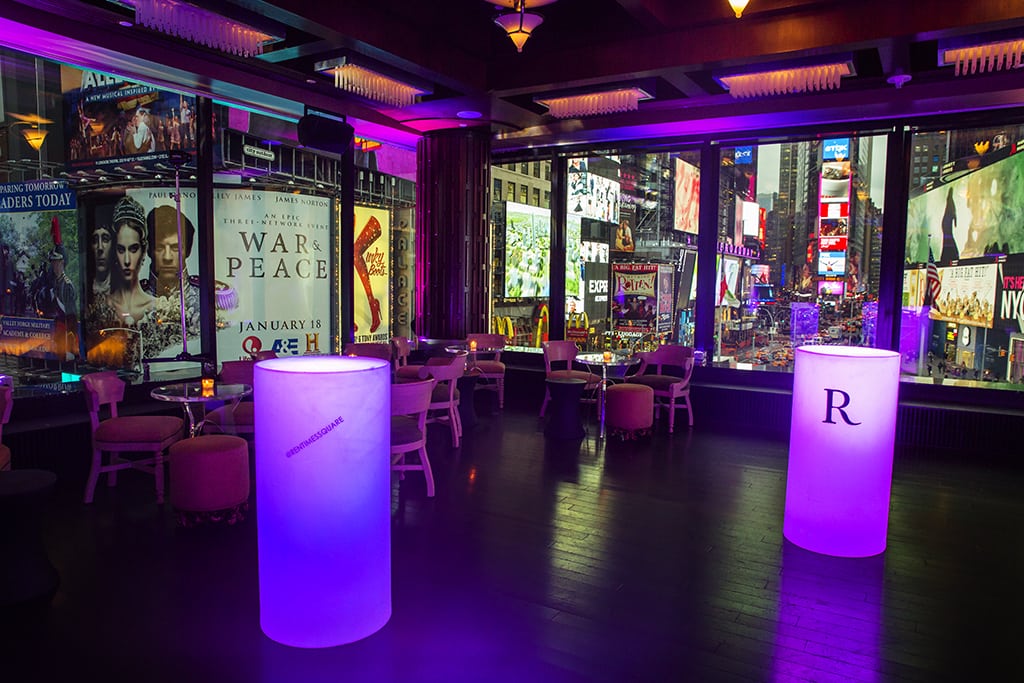Renaissance Hotels Wants to Un-Disney New York’s Times Square

Skift Take
When the Renaissance New York Times Square Hotel wanted to rework the public spaces and convert one floor of meeting spaces to luxury suites with balconies, they turned to local interior designer Benjamin Noriega-Ortiz, principal of BNO Design.
With past experience designing boutique properties for brands like Mondrian Hotels, Noriega-Ortiz brings a nervy aesthetic that contrasts the Disneyfied design dystopia typical in Times Square.
The Renaissance Times Square supports one of the two iconic, towering stacks of neon/video billboards that bookend the pedestrian mall. The hotel’s Living Room lounge, which Noriega-Ortiz redefined, sits directly below the bottom of that signage.
Renaissance is actually required to keep the lights especially low inside the lounge to not compete with the illuminated advertising outside. It’s a surreal view from the inside because the windows are level with the massive outdoor digital branding across the streets on both sides.
Last week during the unveiling of the new design, we sat with Noriega-Ortiz to get inside his head to learn about the future of design in big brand hotels today.
Skift: What is your firm’s overriding philosophy of hotel interior design?
Benjamin Noriega-Ortiz: Our philosophy of design is that the most important thing is feelings, emotions, and how you experience a space. What we design first before we select anything is the emotion that we want to represent in each space. What is it that you want to feel in the space? What are the textures that you want to experience? What is the lighting that you want to experience, the scent, color. Once we determine the experience, then we create an idea for the space.
The idea for this hotel is really a series of discoveries, because I think of the hotel’s lobby and lounge as a garden. Imagine it’s like a walled garden, because as you enter through the elevator you go through a wall into the lounge, which is like a courtyard basically. And as you continue through the space, there are all these different discoveries as if you were walking in a garden.
Skift: What do you mean by “discoveries?”
Noriega-Ortiz: Instead of standard furniture, we often have furniture that is more sculptural. There are pieces that we found around the city, and sometimes we used pieces that were already existing in the hotel, which we didn’t want to throw away. We just reused them. In the lobby, for example, there was furniture that was very ultra modern that was used eight or nine years ago when the hotel was done originally. What we did is, rather than adding all new furniture, I love recycling a lot so I said, “How can I use this furniture and make a new statement?”
So some of what was there that was really modern, we covered it in silver or gold to give it a bit of glitz. Then we added furniture that looked like it would have been in a hotel in Times Square back in the 19th century. You’ll see the furniture that I added was sometimes antique chairs, or piece from an old fashioned barn, like you see in the center of the lobby. There’s also a restored period chair for a tete-a-tete, but for three people.
So by rescuing things from the hotel, we worked in reverse. The lobby has a lot of those experiences, and I think that’s what the future of hospitality is. It is just cultivating all of these new experiences by rediscovering them from before.
Skift: So the space sort of unveils itself to you?
Noriega-Ortiz: As you walk through the space, exactly.
Skift: How or why did you choose this garden setting theme?
Noriega-Ortiz: To me, Times Square is really a garden, an urban walled garden. Because when you look at Times Square, it’s enclosed by walls and it has a particular shape which actually is mimicked in the lobby. And just like Times Square is this big garden with a lot of little secrets, as you walk around the lobby and lounge you discover different things around the corner. And this, of course, is a theme that obviously plays out with the brand.
Skift: Meaning, Renaissance Hotels’ brand pillar of “Discovery.” The emotion you’re trying to create is one of discovery, which aligns with the brand’s positioning around exploring.
Noriega-Ortiz: Yes. I wanted to work for the brand for a while, and this is my first project for them. This new philosophy that they unveiled for the Renaissance brand is fabulous, I really love it. I was excited when they called me to work on this because I was the first one to actually use their new philosophy of design in a full-scale project.
For example, there’s a gigantic table, a performance table in the middle of the lobby. It’s like a Lazy Susan, and you’re actually welcome to go on top and pantomime or sing or perform whatever you want, and there’s even a spotlight.
Skift: When we were walking through the lounge, you showed me where you removed everything, including the bar, that was blocking the windows. You also opened up one wall of windows that the previous design covered. Light and space is really driving hotel design now, isn’t it, as much as decor?
Noriega-Ortiz: I think that the bringing the outside in is huge. I’m working on two other projects right now, one in Switzerland and one here in New York, and it’s the same thing. We’re trying to connect indoor and outdoor. I think people are now more comfortable with being inside and outside, entertaining both ways. You see it in residential design today where there’s so furniture on the market for the outdoors.
So I opened the lounge up by moving the bar from the east to the west away from the windows, and I call that new space “The Terrace.” We used outdoor furniture. There’s stone tables, there’s cement tables, there’s a rickshaw that carries the coffee through the lobby for different events.
We also created a big tall tower of books. That’s part of the interaction between the guests and the hotel. If you finish a book, if you were to go to a house in the Hamptons, you leave it behind. So that’s the idea here. The tower resembles a tree because it’s part of the garden. Books, they were trees at one time.
Skift: When you’re envisioning what you want to create in a hotel space, are you envisioning how your design will encourage social interaction among guests, more so than previously?
Noriega-Ortiz: Yes, yes. I think, and this is one of the most important things for us in our design business, is that people want to interact with each other. I do everything residential in a hotel. It’s because people are on computers so much, and they’re looking at screens so much, that when you go to a hotel, you like to be together. So we have no TVs in the lobby, and that’s on purpose. Or maybe there’s one that was forced to be there, but the idea is to be together.
Another issue I have is, if you want to make a phone call other than texting, it’s too loud. So I created this little phone booth room because there is a calm, quiet feeling in there. As it turned out, people go in there with their laptop, close the door, and do business. It’s kind of like the cone of silence, which is one of those moments that you discover as you’re moving through the lobby.
Skift: But then people aren’t really interacting in there if they’re working on their laptop?
Noriega-Ortiz: Well, the booth was designed for two. I thought more people were going to make out.
Skift: Do you have a specific piece that resonates with you personally the most?
Noriega-Ortiz: There’s a discreet sculpture made out of old clothes stacked together, making a chair. Which to me is the dichotomy of Times Square, having all of these elegant things, old things, and then the homeless in the street. It’s my only political comment. It’s this idea about art as commentary.
The interesting thing is whatever is in this lobby is not duplicated in any other Renaissance, so it’s totally unique to this space. The idea is, if you have all these unique elements that create conversation organically among people, it really gets people interacting.




